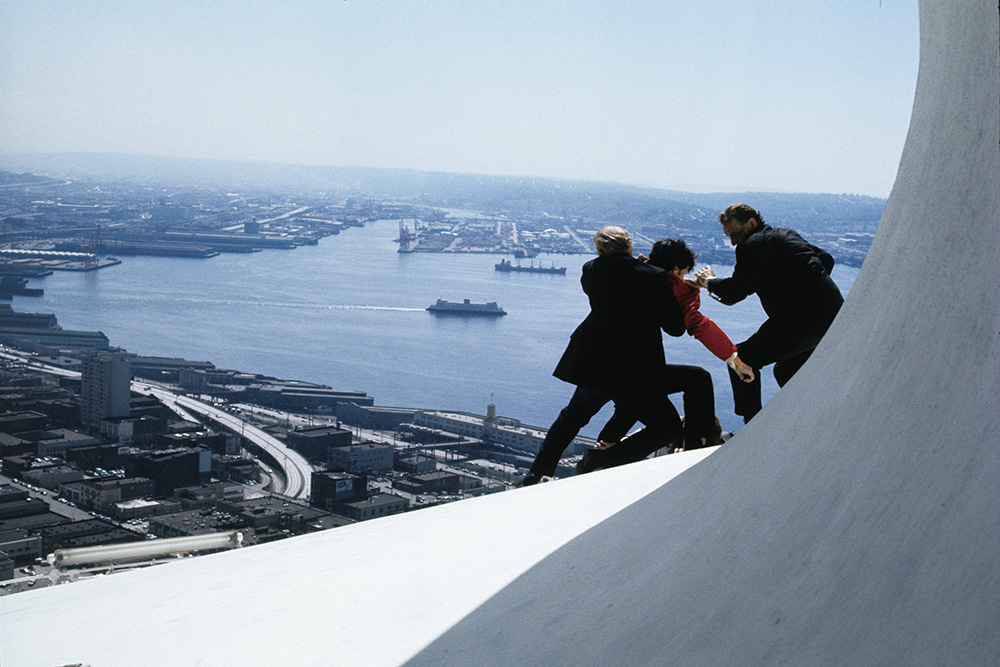With the Watergate scandal dragging into the summer of 1974, Paramount’s conspiracy thriller The Parallax View, with Warren Beatty as a reporter who stumbles onto a mystery surrounding the assassination of a presidential candidate, premiered in New York on June 19 at Cinema 1. It was Beatty’s return to screen after nearly two years working on a real presidential campaign, George McGovern’s doomed run against Richard Nixon. Paranoia must have been in the air since Paramount was rushing The Parallax View into theaters to make way for a more glamorous conspiracy thriller, Roman Polanski’s Chinatown, which premiered the very next day at the Loews State 1 and the Coronet, going on to earn eleven Oscar nominations.
Bookended by political killings, The Parallax View heavily references the assassinations of President John F. Kennedy and his brother Senator Robert F. Kennedy, as well as the untimely deaths of eighteen witnesses of the JFK shooting—the subject of the 1973 Burt Lancaster film Executive Action. But the scope of The Parallax View is broader. Opening with a July 4 parade, the film ties America’s violent past to its turbulent present. And, it also looks ahead with prescience, anticipating a chilling future in which faceless data-gathering corporations take control of everything. The Parallax View was to become part of director Alan Pakula’s paranoia trilogy, including Klute (1971) and All The President’s Men (1976). All three were brilliantly photographed by Gordon Willis, the maverick cinematographer best known for the Godfather trilogy (1972 - 1990) and Woody Allen’s best films, including Annie Hall (1977) and Manhattan (1979). That being said, The Parallax View may well be Willis’s crowning achievement.
If there was an auteur theory developed to recognize cinematographers who had the most decisive control over their films’ style, Willis would be high in the pantheon. His greatness was not only in his ability to deliver spectacular and beautiful shots—countless others could do that—but in the rigorous unity and overall structure he masterfully created for each film he worked on, what he called “visual relativity” in a 2004 interview with Criterion. His method was clarity through elimination; he favored long master shots with few close-ups. Known as “the Prince of Darkness,” he often shot scenes using the smallest amount of light that would register on film. He felt it was a cinematographer’s job to deliver the film’s design and deliberately photographed in a manner that couldn’t be altered in the cutting room. He also favored what he called a slight “distance between the story and the audience,” to quote another interview he conducted in 2004 with the American Society of Cinematographers. His interest was in the movement of “figures in space” above all else and no cinematographer has ever made more expressive use of the negative space surrounding their characters.
Willis’s aesthetic approach was a perfect fit for The Parallax View. He convinced Pakula to use the Panavision widescreen format (the equivalent of CinemaScope) to engulf Beatty’s lone reporter within each frame, unaware of the threats that surround him. The assassinations that frame the movie are breathtaking set pieces. The first takes place on the observation deck of Seattle’s Space Needle, setting the killing against the vertigo-inducing and expansive sunlit cityscape. The second killing takes place in a massive, empty convention hall during the rehearsal for a campaign rally. The setting allows for a cat-and-mouse chase scene that is at once thrilling and Kafkaesque in its play of scale and how it imposes fate on its ultimately powerless protagonist.
The entire film is a study in contrasts; for example, the ultra-modern sci-fi sterility of the Parallax Corporation’s headquarters is balanced by the woodsy warmth of the newspaper office where Beatty’s reporter works. Pakula had suggested a comic-book graphic style to Willis; instead, the latter delivered a symphony of composition and mood worthy of Edward Hopper.
The Parallax View screens tonight, September 4, and tomorrow September 5, at the Museum of Modern Art as part of the series “Paramount in the 1970s.”



